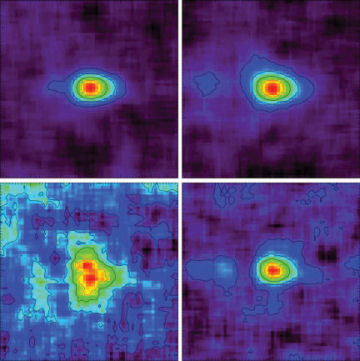Average galaxies
Small, faint, and sluggish, a newly discovered collection of galaxies is helping explain how larger galaxies came to be.
By Emily Sohn
Not everything in space is spectacular, dramatic, or exploding with light. For example, astronomers recently found 27 distant galaxies that are small and faint.
Although far from flashy, the newly discovered galaxies are exciting to scientists because they might represent building blocks that would eventually merge to form massive galaxies like ours. Astronomers have been looking for tiny galaxies like these for more than 30 years.
 |
|
This image shows a glow of hydrogen gas coming from small, faint galaxies that may be the building blocks of larger galaxies, including our own Milky Way. |
| Michael Rauch, et al. |
To make the discovery, Michael Rauch of the Carnegie Observatories in Pasadena, Calif., and his colleagues used the European Southern Observatory’s Very Large Telescope (VLT) in Paranal, Chile. Over a period of several years, they pointed the telescope at the same tiny patch of sky. They recorded 92 hours’ worth of observations—a new record.
When they looked at the images, the scientists noted that the telescope had detected faint levels of a particular wavelength of light, called Lyman-alpha. Different wavelengths of light (including ultraviolet, infrared, and visible) carry different amounts of energy.
Huge, newborn stars produce radiation that causes hydrogen gas inside galaxies to glow. The glow emits Lyman-alpha light. A galaxy’s Lyman-alpha light looks different from Earth depending on how far away the galaxy is.
On the basis of that knowledge, Rauch and colleagues calculated that the 27 newfound galaxies are 12 billion light-years from Earth. The researchers could also tell that stars are forming relatively slowly in these galaxies.
What’s more, the newly discovered galaxies seem to be 20 times as common as a group of better-known galaxies. These more well-known galaxies are just as far away from Earth as the newly discovered galaxies, but they’re bigger and brighter, and they produce more stars.
Even though the new galaxies are not spectacularly bright or huge, astronomers think they might help explain how small galaxies combined over the history of the universe to form larger ones, including the Milky Way.
“Knowing what is going on for these more run-of-the-mill systems will be valuable for testing theories of the [early] galaxy population,” says David Weinberg of Ohio State University in Columbus.
The discovery, he adds, “is a heroic observation, and I hope that it represents the start of an era rather than something the world decides is too expensive to repeat.”
Next, astronomers hope to find more of these ordinary galaxies with ground-based telescopes instead of with instruments in space. That could be one way to cut costs.
Going Deeper:
Cowen, Ron. 2007. Run of the mill: Finding galactic building blocks in early universe. Science News 172(Dec. 15):373-374. Available at http://www.sciencenews.org/articles/20071215/fob6.asp .







